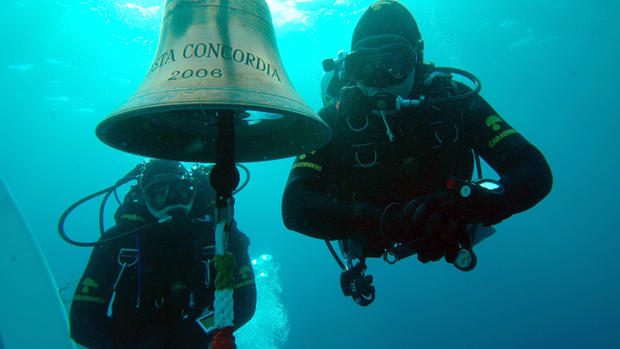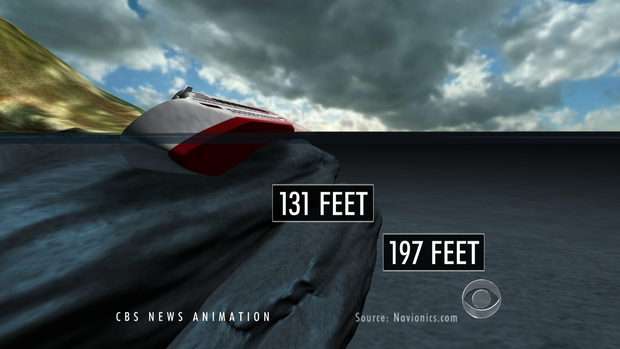Effort to right Costa Concordia starts
Updated 3:10a.m. ET Sept. 16, 2013
Giglio Island, Italy The people of Giglio, who have been living for months in the shadow of the capsized ocean liner Costa Concordia, have been waiting for this day with hope and fear. Now the moment of truth has finally arrived -- the parbuckling effort -- the attempt to rotate the 952-foot-long wreck to an upright position -- began on Monday.
"Will it work?" is the question on every resident's mind, only too aware that no one has provided details of a Plan B.
Engineers said that, initially, at least, all hydraulics systems were working well.
The start of the operation was delayed at least two hours by fierce thunderstorms Monday morning. The storms prevented the positioning of the barge that has the control room and other key units on it.
Rolling the ship off the seabed and onto huge underwater platforms was expected to take eight to ten hours.
The Costa Concordia is around two-and-a-half times the size of the Titanic, and no one wants to see it split apart.
- Huge salvage operation to turn the Costa Concordia
- Costa Concordia: Salvaging a shipwreck
- Grounded Costa Concordia cruise ship is ready to roll, literally
- Tragic final moments of passengers revealed in new Costa Concordia file
Few of the locals will ever forget the night of January 13, 2012, when the huge Costa Concordia struck rocks. There was a mad rush to provide assistance to the thousands fleeing the ship. The harsh reality that 32 people lost their lives in the disaster still haunts many of them.
Two bodies are still missing, and their families are hopeful they will now be found.
Since the tragedy, the people of Giglio have watched their island's port transform itself into a work-in-progress area for an unprecedented salvage operation. A 500-member international team of engineers and mechanics has worked tirelessly for months with one goal in mind: removing the 114,500-ton ship firmly stuck to two outcrops of rock on the seabed.
But it's a hugely complex operation and not one that is without risks. It is those risks that most concern the locals at this time.
They have been assured that all calculations have been made and nothing has been left to chance, but these islanders are concerned. Everyone is aware there are still 237.5 cubic meters of polluted water inside the ship, which could cause significant environmental damage to Giglio's pristine waters.
Additional emergency vehicles have arrived on the island, and as extra precaution, inflatable pollution barriers and fishing nets have been put up around the wreck and along the shoreline, in an effort to hold back any debris or oil that will spew from the Concordia as she turns.
The green light was given to its rotation after it became clear the ship could not remain in its current position another winter.
Nick Sloane, the South African senior salvage master of the operation and project leader for contractors Titan Salvage, said the Concordia would suffer an extreme amount of force of compression in the first moments of the maneuver. But he has expressed confidence that the huge cruise ship will survive the stress.
With the eyes of the world focused on Giglio, Sloane -- who has three decades of experience -- candidly admits this is an extraordinary project which has pooled together the very best engineers and expertise from around the world.
"The size of the ship and her location make this the most challenging operation I've ever been involved in," he said.
As the operation begins, twelve experts will be in the control room positioned at the bow of the ship anxiously staring at their computer screens and listening for every noise the wreck makes.
One of the most critical moments is expected to be the initial pulling of the Concordia off the rocks. "We are not sure about the actual weight and how much the rocks are going to hold onto her. We will be carefully watching all the accelerometers and we will be increasing the tension very slowly until she comes off," Sloane said.
At a rate of three meters per hours, dozens of crank-like pulleys will start slowly rotating the ship. Steel chains weighing 17,000 tons have been looped under the vessel to help hold it together and pull it upright. Also, tanks, known as sponsons, will be filled with water on the port (exposed) side to help rotate it upward.
A massive grouting mattress has been created on the seabed between the two outcrops of rock to provide greater stability to the ship.
"The objective is to get her to move very slowly and gently," Sloane said.
Once the ship moves upward about 25 degrees, "at that point gravity takes over, and there is no going back."
Parbuckling is a tested way to set upright capsized vessels, but never before has this operation been carried out on a cruise liner the size of the Costa Concordia.
Once the ship is pulled upright, an in-depth survey will be carried out to establish the extent of the damage on the starboard side.
The re-floating of the Concordia is not expected before the spring of 2014. Then, it will need to be towed to the mainland. But its final port of destination -- where it will be cut up for scrap -- is still to be decided.
Complete CBSNews.com coverage: Costa Concordia disaster


